This week offers fewer Secret Wars tie-ins than last (“only” six), but more DC debuts (eight), with a couple of indy first issues and the usual bunch of other interesting stuff:
 Secret Wars: Runaways #1 (of 3) — Writer: Noelle Stevenson; Art: Sanford Greene; Colors: John Rauch
Secret Wars: Runaways #1 (of 3) — Writer: Noelle Stevenson; Art: Sanford Greene; Colors: John Rauch
Secret Wars: Squadron Sinister #1 (of 3) — Writer: Marc Guggenheim; Pencils: Carlos Pacheco; Inks: Mariano Taibo; Colors: Frank Martin
Secret Wars: Thors #1 (of 3) — Writer: Jason Aaron; Pencils: Chris Sprouse; Inks: Karl Story; Colors: Marte Gracia
Secret Wars: Armor Wars #2 (of 4) — Writer: James Robinson; Art: Marcio Takara; Colors: Esther Sanz
 Deadpool’s Secret Secret Wars #2 (of 4) — Writer: Cullen Bunn; Art: Matteo Lolli; Colors: Ruth Redmond
Deadpool’s Secret Secret Wars #2 (of 4) — Writer: Cullen Bunn; Art: Matteo Lolli; Colors: Ruth Redmond
Secret Wars: Old Man Logan #2 (of 4) — Writer: Brian Michael Bendis; Art: Andrea Sorrentino; Colors: Marcelo Maiolo
Runaways has, really, nothing to do with the previous incarnations of that title; it’s about an elite academy for (mostly) super-powered students — the Victor Von Doom Institute for Gifted Youths — among whom are Jubilee, Pixie, Amadeus Cho, Molly Hayes (from Power Pack), Cloak and Dagger 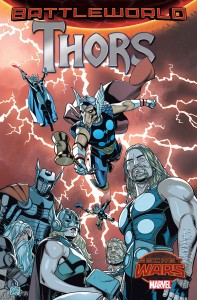 and a couple of others. Greene’s manga-influenced art makes it attractive (and, any more, is almost a standard style for a book like this), but its most intriguing feature is the script by Lumberjanes co-writer Noelle Stevenson; that book is an almost-perfect kids’-group title, so she’s an inspired choice for this series, and brings the same knacks for character interaction and combining humor and drama that make it so good. Squadron Sinister is candy for continuity buffs: it’s about the original, mostly-criminal versions of those characters, who spend their time conquering neighboring sections of the Secret Wars planet and annexing them: when we meet them, they’re annihilating their “Squadron
and a couple of others. Greene’s manga-influenced art makes it attractive (and, any more, is almost a standard style for a book like this), but its most intriguing feature is the script by Lumberjanes co-writer Noelle Stevenson; that book is an almost-perfect kids’-group title, so she’s an inspired choice for this series, and brings the same knacks for character interaction and combining humor and drama that make it so good. Squadron Sinister is candy for continuity buffs: it’s about the original, mostly-criminal versions of those characters, who spend their time conquering neighboring sections of the Secret Wars planet and annexing them: when we meet them, they’re annihilating their “Squadron  Supreme” counterparts from the J. M. Straczynski series, and we also see them encountering characters from ’80s Marvel offshoots like the New Universe and, even more obscure, the Shadowline imprint (Dr. Zero, Order of St. George, etc.). If you were reading a lot of comics back then, it’s fun to play spot-the-hero, and artist Pacheco has just the right straight-ahead, solid superhero style to be able to handle all the different members of the cast and make them look good. Thors is one of the best tie-ins of the week, partly because the idea of the police force on Doom’s planet as being made up entirely of versions of the Thunderer is cool, partly since Aaron’s been writing the regular Thor comic for quite a while, and knows his way around the various Asgardian incarnations, and
Supreme” counterparts from the J. M. Straczynski series, and we also see them encountering characters from ’80s Marvel offshoots like the New Universe and, even more obscure, the Shadowline imprint (Dr. Zero, Order of St. George, etc.). If you were reading a lot of comics back then, it’s fun to play spot-the-hero, and artist Pacheco has just the right straight-ahead, solid superhero style to be able to handle all the different members of the cast and make them look good. Thors is one of the best tie-ins of the week, partly because the idea of the police force on Doom’s planet as being made up entirely of versions of the Thunderer is cool, partly since Aaron’s been writing the regular Thor comic for quite a while, and knows his way around the various Asgardian incarnations, and 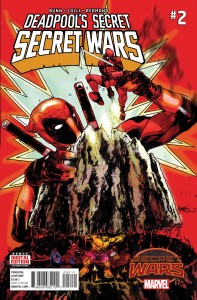 also because Sprouse, like Pacheco, has been around long enough (he’s probably best known for his work on the Alan Moore Tom Strong) to know how to handle multiple characters and classic superhero situations well; it also helps that the plot involves an interesting mystery with a classic cliffhanger reveal on the last page. Armor Wars continues its tale of a slightly-future timeline city where all the inhabitants, because of a debilitating disease, have to wear Iron Man-like suits all the time; it’s another murder mystery, with the Peter Parker/Spider-Man version having been murdered, and Jim Rhodes trying to figure out whodunnit. OK, although Takara’s art doesn’t mesh with the high-tech suits and other machines very well, and the plot, half-way through the series, seems too
also because Sprouse, like Pacheco, has been around long enough (he’s probably best known for his work on the Alan Moore Tom Strong) to know how to handle multiple characters and classic superhero situations well; it also helps that the plot involves an interesting mystery with a classic cliffhanger reveal on the last page. Armor Wars continues its tale of a slightly-future timeline city where all the inhabitants, because of a debilitating disease, have to wear Iron Man-like suits all the time; it’s another murder mystery, with the Peter Parker/Spider-Man version having been murdered, and Jim Rhodes trying to figure out whodunnit. OK, although Takara’s art doesn’t mesh with the high-tech suits and other machines very well, and the plot, half-way through the series, seems too 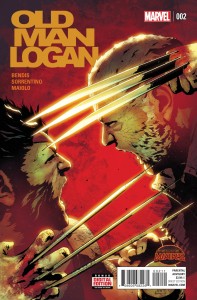 uneasy to unravel (although maybe that’s a feint from writer Robinson…). Deadpool’s Secret Secret Wars ignores the whole Doom-planet idea completely, in favor of looking back at the original Secret Wars title from the ’80s, and inserting Wade into it retroactively. Lolli’s pretty good at not-quite-mimicking the original Mike Zeck versions of all the characters, but the plot only works if you’ve read the original series; if not, you’ll have no idea what’s going on, and will miss a lot of the humor. Finally, Old Man Logan has that character encountering an earlier version of the X-Men whom, in his own timeline, he killed (not on purpose, but still…), with typical Bendis scripting and suitably-shadow-infused art from Sorrentino; there’ve been some hints that this version of the Canucklehead might end up in regular Marvel continuity post-Secret Wars (so we’ll have a Logan back, but a much different and even-more-conflicted one), which might give readers another incentive to seek out this book.
uneasy to unravel (although maybe that’s a feint from writer Robinson…). Deadpool’s Secret Secret Wars ignores the whole Doom-planet idea completely, in favor of looking back at the original Secret Wars title from the ’80s, and inserting Wade into it retroactively. Lolli’s pretty good at not-quite-mimicking the original Mike Zeck versions of all the characters, but the plot only works if you’ve read the original series; if not, you’ll have no idea what’s going on, and will miss a lot of the humor. Finally, Old Man Logan has that character encountering an earlier version of the X-Men whom, in his own timeline, he killed (not on purpose, but still…), with typical Bendis scripting and suitably-shadow-infused art from Sorrentino; there’ve been some hints that this version of the Canucklehead might end up in regular Marvel continuity post-Secret Wars (so we’ll have a Logan back, but a much different and even-more-conflicted one), which might give readers another incentive to seek out this book.
 Black Canary #1 — Writer: Brenden Fletcher; Art: Annie Wu; Colors: Lee Loughridge
Black Canary #1 — Writer: Brenden Fletcher; Art: Annie Wu; Colors: Lee Loughridge
Doctor Fate #1 — Writer: Paul Levitz; Art: Sonny Liew; Colors: Lee Loughridge
Doomed #1 — Writer: Scott Lobdell; Art: Javier Fernandez; Colors: Ulises Arreola
Harley Quinn and Power Girl #1 (of 6) — Writers: Amanda Connor, Jimmy Palmiotti and Justin Gray; Art: Stephane Roux; Colors: Paul Mounts
 Martian Manhunter #1 — Writer: Rob Williams; Pencils: Eddy Barrows; Inks: Eber Ferreira; Colors: Gabe Eltaeb
Martian Manhunter #1 — Writer: Rob Williams; Pencils: Eddy Barrows; Inks: Eber Ferreira; Colors: Gabe Eltaeb
Prez #1 — Writer: Mark Russell; Pencils: Ben Caldwell; Inks: Mark Morales; Colors: Jeremy Lawson
Robin, Son of Batman #1 — Writer/Pencils: Patrick Gleason; Inks: Mick Gray; Colors: John Kalisz
Justice League of America #1 — Writer/Pencils:  Bryan Hitch; Inks: Daniel Henriques with Wade von Grawbadger and Andrew Currie; Colors: Alex Sinclair with Jeromy Cox
Bryan Hitch; Inks: Daniel Henriques with Wade von Grawbadger and Andrew Currie; Colors: Alex Sinclair with Jeromy Cox
Lots of DC first issues this week, so let’s take them in alphabetical order: Black Canary is by one of the co-writers of the new version of Batgirl, and uses a lot of that comic’s tone and continuity; since Batgirl‘s been a deserved hit, a cool modern version of the character, this version of Dinah, where she’s joined a 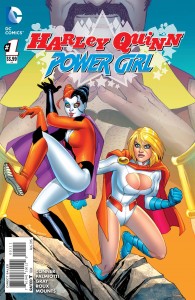 band (it’s the band whose name is “Black Canary”), but is pursued by figurative demons from her past — even while another band member is pursued by more-literal ones — is worth checking out too, with the Wu art giving it a clean, well-designed and energetic look. Doctor Fate is yet another new version of that character, with the twist of the ancient Egyptian helmet picking an actual Egyptian (specifically, an Egyptian-American medical student) as its avatar; this first-issue plot is pretty standard (he refuses to believe it’s real, is forced to by an otherworldly crisis, etc.), but helped considerable by the Sonny Liew art,
band (it’s the band whose name is “Black Canary”), but is pursued by figurative demons from her past — even while another band member is pursued by more-literal ones — is worth checking out too, with the Wu art giving it a clean, well-designed and energetic look. Doctor Fate is yet another new version of that character, with the twist of the ancient Egyptian helmet picking an actual Egyptian (specifically, an Egyptian-American medical student) as its avatar; this first-issue plot is pretty standard (he refuses to believe it’s real, is forced to by an otherworldly crisis, etc.), but helped considerable by the Sonny Liew art, 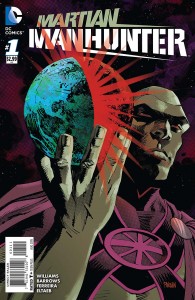 which is fluidly cartoony enough to make the human characters appealing, but the supernatural ones weird and menacing, and the fact that writer Levitz has been writing DC comics for over 40 years now, and knows precisely how to create a smooth, entertaining experience for readers. Doomed has an interesting premise — a college freshman gets infected with the Doomsday virus — and isn’t bad, but is utterly generic: look at that cover, which could have adorned practically any Hulk comic (and a number of others too), while the plot seems to be going exactly where you’d expect it to; maybe it will make some interesting swerves, although author
which is fluidly cartoony enough to make the human characters appealing, but the supernatural ones weird and menacing, and the fact that writer Levitz has been writing DC comics for over 40 years now, and knows precisely how to create a smooth, entertaining experience for readers. Doomed has an interesting premise — a college freshman gets infected with the Doomsday virus — and isn’t bad, but is utterly generic: look at that cover, which could have adorned practically any Hulk comic (and a number of others too), while the plot seems to be going exactly where you’d expect it to; maybe it will make some interesting swerves, although author 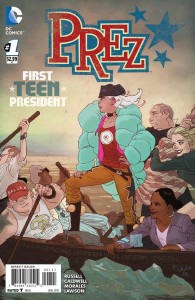 Lobdell’s history doesn’t provide a lot of cause for optimism. Harley Quinn and Power Girl is another book where readers know pretty much what they’re getting, since it’s by the regular Harley team of writers (with longtime Palmiotti collaborator Gray part of the mix too), but the characters-in-space plot, the light touch, and the fact that it’s a mini-series (and so, presumably, won’t wear out its welcome) work in its favor. Martian Manhunter is the opposite of “light,” with its everything-you-know-is-wrong take on the character and alien-invasion plot, but its Men In Black ideas on aliens being everywhere among us, its well-constructed plotting, and its detailed, eerie art
Lobdell’s history doesn’t provide a lot of cause for optimism. Harley Quinn and Power Girl is another book where readers know pretty much what they’re getting, since it’s by the regular Harley team of writers (with longtime Palmiotti collaborator Gray part of the mix too), but the characters-in-space plot, the light touch, and the fact that it’s a mini-series (and so, presumably, won’t wear out its welcome) work in its favor. Martian Manhunter is the opposite of “light,” with its everything-you-know-is-wrong take on the character and alien-invasion plot, but its Men In Black ideas on aliens being everywhere among us, its well-constructed plotting, and its detailed, eerie art 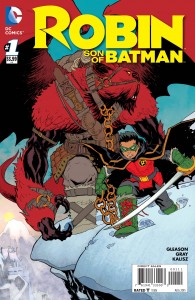 make it an effective horror comic, and do a good job of making readers want to pick up the book’s next issue. Prez, about a teenage girl who becomes POTUS, has a loose style and some imagination, but two problems: one is that that it’s a satire, but the targets are all so obvious — Big businesses and politicians are corrupt! Reality TV is making us stupid! — that it has little bite, or shock value, while another is that it’s a good example of the dangers of writing for the trade, with a first issue that ends before the main character even becomes president; that’s fine if it’s just one chapter of a longer work in the readers’ hands, but possibly fatal as a single comic, since it gives readers little sense of what the book’s going to look like, or reason to come back. This isn’t the worst of the DC
make it an effective horror comic, and do a good job of making readers want to pick up the book’s next issue. Prez, about a teenage girl who becomes POTUS, has a loose style and some imagination, but two problems: one is that that it’s a satire, but the targets are all so obvious — Big businesses and politicians are corrupt! Reality TV is making us stupid! — that it has little bite, or shock value, while another is that it’s a good example of the dangers of writing for the trade, with a first issue that ends before the main character even becomes president; that’s fine if it’s just one chapter of a longer work in the readers’ hands, but possibly fatal as a single comic, since it gives readers little sense of what the book’s going to look like, or reason to come back. This isn’t the worst of the DC 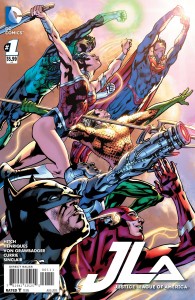 debuts this month, but I suspect it’ll be the first to be cancelled. Robin, Son of Batman is about just what its title says, with Damian Wayne as its protagonist, trying to undo various League of Assassin schemes with the help of a giant mutant bat named Goliath (because, well, why the hell not?). This has the opposite problem of Prez: it’s good at showing its premise — an eleven-year-old kid who’s equal parts snarky, deadly and struggling to fulfill his father’s heroic legacy — but crams so many different parts into this first issue that it’s hard to follow even for readers already familiar with its cast and backstory; brand-new ones risk being totally lost. Justice League of America — the new sister title to the still-ongoing Justice League — strikes a better balance, although it has the advantage of characters we already know intimately, and so can jump right into its coming-apocalypse plot without fear of leaving anyone behind. Hitch is providing both art and script; the words are OK, but that’s all that’s needed, since the main attraction is his widescreen, high-energy drawing, and that’s in fine form here, especially with the double-sized launch giving him 47 pages to display it.
debuts this month, but I suspect it’ll be the first to be cancelled. Robin, Son of Batman is about just what its title says, with Damian Wayne as its protagonist, trying to undo various League of Assassin schemes with the help of a giant mutant bat named Goliath (because, well, why the hell not?). This has the opposite problem of Prez: it’s good at showing its premise — an eleven-year-old kid who’s equal parts snarky, deadly and struggling to fulfill his father’s heroic legacy — but crams so many different parts into this first issue that it’s hard to follow even for readers already familiar with its cast and backstory; brand-new ones risk being totally lost. Justice League of America — the new sister title to the still-ongoing Justice League — strikes a better balance, although it has the advantage of characters we already know intimately, and so can jump right into its coming-apocalypse plot without fear of leaving anyone behind. Hitch is providing both art and script; the words are OK, but that’s all that’s needed, since the main attraction is his widescreen, high-energy drawing, and that’s in fine form here, especially with the double-sized launch giving him 47 pages to display it.
 Superman and Wonder Woman #18 — Writer: Peter Tomasi; Pencils: Doug Mahnke; Inks: Four Guys; Colors: Wil Quintana
Superman and Wonder Woman #18 — Writer: Peter Tomasi; Pencils: Doug Mahnke; Inks: Four Guys; Colors: Wil Quintana
Secret Six #3 — Writer: Gail Simone; Art: Dale Eaglesham; Colors: Jason Wright
Astro City #24 — Writer: Kurt Busiek; Art: Brent Eric Anderson; Colors: Wendy Broome
A few more DC ongoing series of interest — 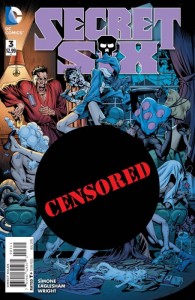 Superman/Wonder Woman almost counts as a debut, since it’s the first issue with a vastly-depowered, outed Superman, on the run from the authorities, as he gets a frantic call from Lana Lang in Smallville, and Diana flies him there to investigate; they encounter a lot of evidence of government strongarm tactics, culminating in a last-page setup involving a federally-sanctioned group that readers will be, happily, familiar with. Mahnke’s a good choice for art, with his grim, buzz-cut Superman and imposing Diana, plus his double-page splash of next issue’s antagonists near the end that should bring everyone
Superman/Wonder Woman almost counts as a debut, since it’s the first issue with a vastly-depowered, outed Superman, on the run from the authorities, as he gets a frantic call from Lana Lang in Smallville, and Diana flies him there to investigate; they encounter a lot of evidence of government strongarm tactics, culminating in a last-page setup involving a federally-sanctioned group that readers will be, happily, familiar with. Mahnke’s a good choice for art, with his grim, buzz-cut Superman and imposing Diana, plus his double-page splash of next issue’s antagonists near the end that should bring everyone 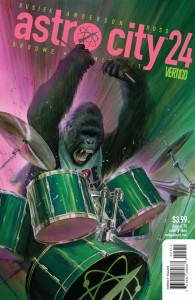 back for more next month. Secret Six has its core group of… well, not “good” guys, but not quite entirely bad either… on the run from the mysterious Mockingbird, and ending up in a Gotham City suburb; their Addams-family-like encounters with the locals form much of the humor of the issue, with Simone delivering a typically-caustic script and Eaglesham matching her in his ability to combine caricature with more-serious scenes to create an appealing (if sometimes disgusting) mix. Astro City, meanwhile, offers the second of a two-part story about a talking gorilla, just a regular (if hairy and super-strong) guy trying to make it in the big city, and Busiek and Anderson’s storytelling is at the same dependably-high level it’s been achieving for the last twenty years.
back for more next month. Secret Six has its core group of… well, not “good” guys, but not quite entirely bad either… on the run from the mysterious Mockingbird, and ending up in a Gotham City suburb; their Addams-family-like encounters with the locals form much of the humor of the issue, with Simone delivering a typically-caustic script and Eaglesham matching her in his ability to combine caricature with more-serious scenes to create an appealing (if sometimes disgusting) mix. Astro City, meanwhile, offers the second of a two-part story about a talking gorilla, just a regular (if hairy and super-strong) guy trying to make it in the big city, and Busiek and Anderson’s storytelling is at the same dependably-high level it’s been achieving for the last twenty years.
 Empty Zone #1 — Writer/Artist: Jason Shawn Alexander; Colors: Luis Nct
Empty Zone #1 — Writer/Artist: Jason Shawn Alexander; Colors: Luis Nct
The Fiction #1 (of 4) — Writer: Curt Pires; Art: David Rubin; Colors: Michael Garland
Just a couple of indy first issues: Empty Zone is a gritty science-fiction tale about a woman who’s some kind of bounty hunter/espionage freelancer, one of those dystopian stories where everyone’s got some kind of high-tech body enhancements, people don’t stay dead, and most of the action takes place in a lower-class bar. For what it is, it’s done quite well, with Alexander keeping things interesting enough to 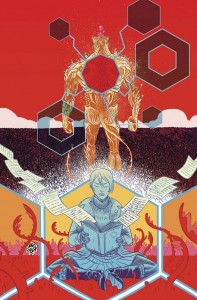 attract readers and mysterious enough to bring them back, and showcasing a dreamy, detailed and painterly style (the cover gives you a pretty good idea of what to expect). The Fiction is a cross between Unwritten and Jumanji, with a group of kids discovering a supernatural book that draws them into a multi-fictional adventure world, where, after one disappears, the rest disband and try to forget about it as a childhood fantasy — until, years later, the book shows up again…. As an ongoing series, it would probably be too derivative to work, but four issues looks to be just about right, giving its colorful, sometimes-surreal art and solid characterization just enough room to tell the story and move on.
attract readers and mysterious enough to bring them back, and showcasing a dreamy, detailed and painterly style (the cover gives you a pretty good idea of what to expect). The Fiction is a cross between Unwritten and Jumanji, with a group of kids discovering a supernatural book that draws them into a multi-fictional adventure world, where, after one disappears, the rest disband and try to forget about it as a childhood fantasy — until, years later, the book shows up again…. As an ongoing series, it would probably be too derivative to work, but four issues looks to be just about right, giving its colorful, sometimes-surreal art and solid characterization just enough room to tell the story and move on.
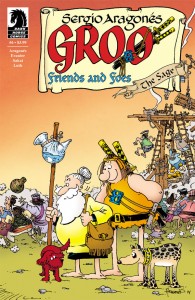 Groo: Friends and Foes #6 (of 12) — Story/Art: Sergio Aragones; Words: Mark Evanier; Colors: Tom Luth
Groo: Friends and Foes #6 (of 12) — Story/Art: Sergio Aragones; Words: Mark Evanier; Colors: Tom Luth
Low #7 — Writer: Rick Remender; Art: Greg Tocchini; Colors: Wooton
Lumberjanes #15 — Writers: Noelle Stevenson and Shannon Watters; Art: Brooke Allen; Colors: 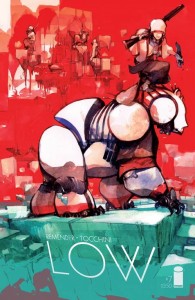 Maarta Laiho
Maarta Laiho
Mind MGMT #34 — Creator: Matt Kindt
Stumptown #6 — Writer: Greg Rucka; Art: Justin Greenwood; Colors: Ryan Hill
Southern Bastards #9 — Writer: Jason Aaron; Art/Colors: Jason Latour
 Stray Bullets: Sunshine and Roses #5 — Creator: David Lapham
Stray Bullets: Sunshine and Roses #5 — Creator: David Lapham
Trees #10 — Writer: Warren Ellis; Art/Colors: Jason Howard
Usagi Yojimbo #146 — Creator: Stan Sakai
 These are all the indy books that caught my eye this week, each one an established series by experienced storytellers (and some, like Groo and Usagi Yojimbo, stretching back three decades). Groo‘s been focusing each issue of its yearlong maxi-series on some member of the bumbling barbarian’s supporting cast, and in this issue it’s The Sage, practically the only member with any brains (not that they help him much when
These are all the indy books that caught my eye this week, each one an established series by experienced storytellers (and some, like Groo and Usagi Yojimbo, stretching back three decades). Groo‘s been focusing each issue of its yearlong maxi-series on some member of the bumbling barbarian’s supporting cast, and in this issue it’s The Sage, practically the only member with any brains (not that they help him much when  Groo’s around…); otherwise, it’s the same well-drawn, intricately-plotted slapstick Aragones and Evanier have been giving us for all those decades. Low, a much more recent book, is beginning its second arc with a stand-alone story that doesn’t require any prior knowledge of its distant-future sf plot or characters from readers, and offers a perfect jumping-on point; it’s about two women, living in a city where optimism and hope are crimes (especially when expressed through art), and its
Groo’s around…); otherwise, it’s the same well-drawn, intricately-plotted slapstick Aragones and Evanier have been giving us for all those decades. Low, a much more recent book, is beginning its second arc with a stand-alone story that doesn’t require any prior knowledge of its distant-future sf plot or characters from readers, and offers a perfect jumping-on point; it’s about two women, living in a city where optimism and hope are crimes (especially when expressed through art), and its 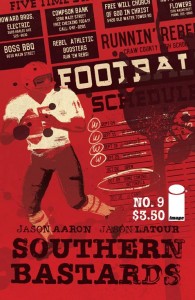 poignant, violent events and gorgeous art by Tocchini should be enough to convince newcomers to stick around. I was praising Noelle Stevenson’s abilities way back up in the first review of this list, Runaways, and the new issue of Lumberjanes continues to show her skills (along with those of co-writer Shannon Watters and artist Brooke Allen), as this comic about friendship, adventure and girl power hints at a few of the secrets of its title group and the mysterious forest surrounding their summer camp, while filling in some of camp director Rosie’s backstory through her frenemy Abigail, a new
poignant, violent events and gorgeous art by Tocchini should be enough to convince newcomers to stick around. I was praising Noelle Stevenson’s abilities way back up in the first review of this list, Runaways, and the new issue of Lumberjanes continues to show her skills (along with those of co-writer Shannon Watters and artist Brooke Allen), as this comic about friendship, adventure and girl power hints at a few of the secrets of its title group and the mysterious forest surrounding their summer camp, while filling in some of camp director Rosie’s backstory through her frenemy Abigail, a new 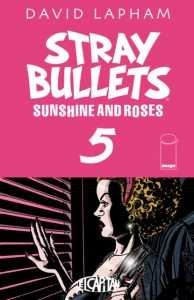 character, offering big, menacing, glowing-eyed talking wolves, and in general just keeping being one of the best new books, of any genre, on the stands right now. Mind MGMT, meanwhile, is deep into its home stretch (34 issues done; two to go), with its surreal story (about various weird psychic operatives of a shadowy government agency) demonstrating how much impact one artist with a unique vision can have in today’s sprawling comics marketplace. That marketplace also has room for more traditional, only-slightly-tilted genre efforts like Stumptown, a hardboiled detective tale
character, offering big, menacing, glowing-eyed talking wolves, and in general just keeping being one of the best new books, of any genre, on the stands right now. Mind MGMT, meanwhile, is deep into its home stretch (34 issues done; two to go), with its surreal story (about various weird psychic operatives of a shadowy government agency) demonstrating how much impact one artist with a unique vision can have in today’s sprawling comics marketplace. That marketplace also has room for more traditional, only-slightly-tilted genre efforts like Stumptown, a hardboiled detective tale 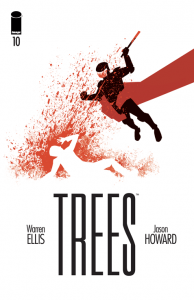 set in Portland instead of LA, with a woman as its main character, which is on something like its fifth novel now and continues to meld eagle-eyed characterization and a deep supporting cast with its uniquely-Portlandian milieu (the plot Maguffin this time around involves three pounds of wild Thai civit coffee beans worth over $25,000, and if that description intrigues you, this is your comic). Southern Bastards offers a similar, but much grimmer, regional analysis, this time of deep-South small towns, with their football-obsessed, interbred rivalries and hardscrabble Gothic histories. David Lapham’s Stray Bullets offers a comparable lowlife-criminal view of Baltimore in the early ’80s, with his suburban tough gals and hard-
set in Portland instead of LA, with a woman as its main character, which is on something like its fifth novel now and continues to meld eagle-eyed characterization and a deep supporting cast with its uniquely-Portlandian milieu (the plot Maguffin this time around involves three pounds of wild Thai civit coffee beans worth over $25,000, and if that description intrigues you, this is your comic). Southern Bastards offers a similar, but much grimmer, regional analysis, this time of deep-South small towns, with their football-obsessed, interbred rivalries and hardscrabble Gothic histories. David Lapham’s Stray Bullets offers a comparable lowlife-criminal view of Baltimore in the early ’80s, with his suburban tough gals and hard-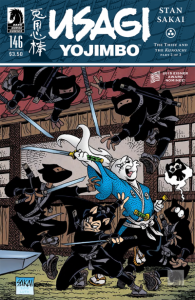 edged, taciturn Midwestern mobsters. Trees offers the same noirish sensibilities, but wrapped around a science-fiction plot about huge alien cylinders plopping down all over the earth and just sitting there; they make various local authorities no less corrupt, and the common-folk investigators just as noble, as in any of the other series. That leaves Usagi Yojimbo, Stan Sakai’s talking-animal samurai — like Groo, a book equally accessible for kids or adults, one that’s been around so long its creator has its tales of feudal Japan down to a smooth, dependable art; this issue spotlights the street-performer con artist Kitsune and her ward, plus the usual ninja battles and intrigue, and even though it’s the second of a three-part story it gives the reader a clear, satisfying comic to enjoy.
edged, taciturn Midwestern mobsters. Trees offers the same noirish sensibilities, but wrapped around a science-fiction plot about huge alien cylinders plopping down all over the earth and just sitting there; they make various local authorities no less corrupt, and the common-folk investigators just as noble, as in any of the other series. That leaves Usagi Yojimbo, Stan Sakai’s talking-animal samurai — like Groo, a book equally accessible for kids or adults, one that’s been around so long its creator has its tales of feudal Japan down to a smooth, dependable art; this issue spotlights the street-performer con artist Kitsune and her ward, plus the usual ninja battles and intrigue, and even though it’s the second of a three-part story it gives the reader a clear, satisfying comic to enjoy.



